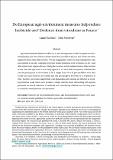Files in this item
Do European agri-environment measures help reduce herbicide use? Evidence from viticulture in France
Item metadata
| dc.contributor.author | Kuhfuss, Laure | |
| dc.contributor.author | Subervie, Julie | |
| dc.date.accessioned | 2019-04-04T23:38:13Z | |
| dc.date.available | 2019-04-04T23:38:13Z | |
| dc.date.issued | 2018-07-01 | |
| dc.identifier | 252741324 | |
| dc.identifier | 5522b9d5-d672-434e-8381-c7d1d8ea7569 | |
| dc.identifier | 85044448522 | |
| dc.identifier | 000433014500018 | |
| dc.identifier.citation | Kuhfuss , L & Subervie , J 2018 , ' Do European agri-environment measures help reduce herbicide use? Evidence from viticulture in France ' , Ecological Economics , vol. 149 , pp. 202-211 . https://doi.org/10.1016/j.ecolecon.2018.03.015 | en |
| dc.identifier.issn | 0921-8009 | |
| dc.identifier.uri | https://hdl.handle.net/10023/17456 | |
| dc.description | Funding for this research was provided by the French Agency for Water and Aquatic Environments (1073/2012) (ONEMA) as part of the 2011 call for projects ‘Changer les pratiques agricoles pour preserver les services ecosystemiques' supporting the implementation of the French National Action plan Ecophyto 2018. This paper was partly funded by the Rural & Environment Science & Analytical Services Division of the Scottish Government. | en |
| dc.description.abstract | Agri-environmental schemes (AES) are a central component of the European environmental policy, but few of these schemes have been carefully evaluated and doubts are often expressed about their effectiveness. We use original data collected from winegrowers who participated in an AES targeting non-point source pollution from herbicides in 2011 and 2012 in the South region of France. Using the variation in the implementation of the scheme across time and space and a matching approach, we show that the quantity of herbicides used by participants in the scheme in 2011 ranges from 38 to 53% below what they would have used without the scheme and this percentage is between 42 and 50% in 2012. Further, our results suggest that least demanding AES options are effective in avoiding pollution peaks when weed pressure is high, whereas more demanding AES options guarantee an overall reduction in herbicide use, even during relatively easy farming years in which less weed pressure is experienced. | |
| dc.format.extent | 10 | |
| dc.format.extent | 287527 | |
| dc.language.iso | eng | |
| dc.relation.ispartof | Ecological Economics | en |
| dc.subject | Agri-environmental scheme | en |
| dc.subject | Herbicides | en |
| dc.subject | Nonpoint source pollution | en |
| dc.subject | Payments for environmental services | en |
| dc.subject | Pesticides | en |
| dc.subject | Treatment effect | en |
| dc.subject | Water quality | en |
| dc.subject | G Geography (General) | en |
| dc.subject | S Agriculture (General) | en |
| dc.subject | HB Economic Theory | en |
| dc.subject | Environmental Science(all) | en |
| dc.subject | Economics and Econometrics | en |
| dc.subject | NDAS | en |
| dc.subject.lcc | G1 | en |
| dc.subject.lcc | S1 | en |
| dc.subject.lcc | HB | en |
| dc.title | Do European agri-environment measures help reduce herbicide use? Evidence from viticulture in France | en |
| dc.type | Journal article | en |
| dc.contributor.institution | University of St Andrews. School of Geography & Sustainable Development | en |
| dc.identifier.doi | https://doi.org/10.1016/j.ecolecon.2018.03.015 | |
| dc.description.status | Peer reviewed | en |
| dc.date.embargoedUntil | 2019-04-05 |
This item appears in the following Collection(s)
Items in the St Andrews Research Repository are protected by copyright, with all rights reserved, unless otherwise indicated.

